The techwear community is mostly made up of men and clothes designed for their bodies. But there is also a hidden lineage of women’s techwear.
Techwear is a fashion subculture centered around the principles of utility through technical innovation with an aesthetic that leans towards the futuristic. Nothing about this is inherently gendered, people of all gender expressions may be interested in functional, versatile, good looking garments; everyone wants a raincoat when it rains. Yet the big name techwear designers are men, many popular brands produce only men’s ranges, and the majority of contributors to techwear forums are men.
Recently, a Reddit user asked if the popular techwear community r/techwearclothing is only for men’s clothes. The majority of commenters replied with a welcoming attitude: Techwear is androgynous, unisex or gender neutral; anyone can wear anything, women are welcome and encouraged to participate.
This response from the community is encouraging, although there is an important nuance in the original poster’s question — they did not ask “is this space only for men?” but “is this space only for men’s clothing?” (emphasis mine).
It is easy to design something for cis men, call it unisex, and say it is for everyone. This bias is extremely common: in adventure gear, artificial hearts, medical care. This is where techwear’s relationship with androgyny becomes a problem. Without addressing how gender bias impacts techwear, women, transgender, and nonbinary people will continue to be outliers in the subculture.
Our general culture presents men as the default human and the default body, so androgyny is commonly expressed as not-men wearing men’s clothing. Gender neutral = men’s. Unisex = men’s.
In current fashion, androgyny has the connotation of hot women wearing men’s suits. As Meg Zulch writes on Bustle.com:
Apparent in Zara’s Ungendered Collection and in many gender neutral lines before it, androgyny is often equated with masculinity, or women “borrowing from the boys.” … Cis-passing women modeling loose and boyish neutral-hued clothing… But the actual definition of the word implies an even balance between the feminine and masculine, or an absence of either. But “androgyny” as it’s often expressed in fashion does not actually represent a full scope of gender, nor does it speak much beyond women wearing masculine apparel.
Do a Google image search for androgynous fashion and you will see image after image of (thin, white) women wearing men’s clothes.
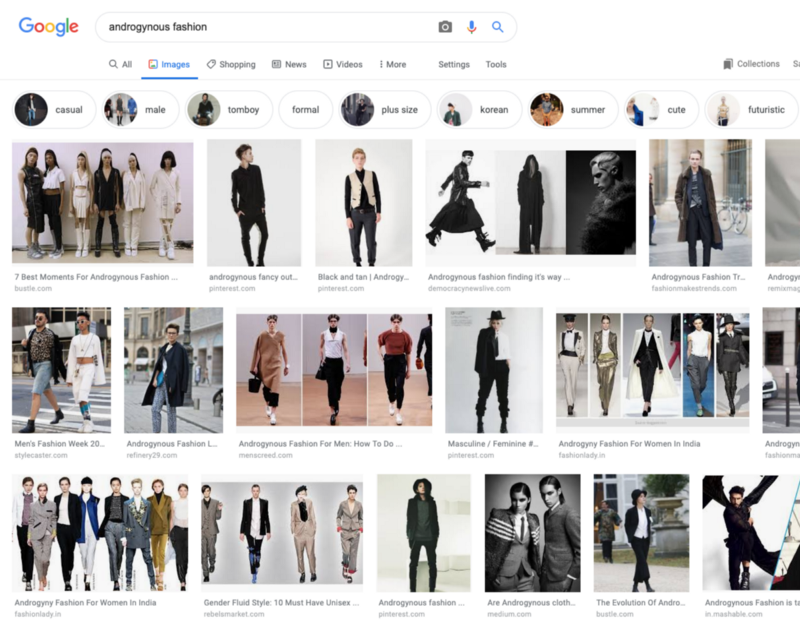
I recommend Kris Nelson’s article on Everyday Feminism, which makes the following points on the problematic way in which androgyny is depicted:
- White is too frequently depicted as default.
- Thinness is code for gender neutrality.
- Masculinity is recognized as being genderless.
- Femininity is defaulted as ‘other’.
To be truly androgynous, a fashion or subculture would have to embrace elements of both female and male-coded styles. (consider Young Thug and Rain Dove). If techwear was truly androgynous, there would be more male-presenting and gender non-conforming people wearing feminine-coded clothing: skirts, dresses, women’s shoes, not only the big sizes of women’s ACG parkas and cargos.
If the default body is thin and male, most techwear clothing will fit poorly on bodies that are not thin and male. This would be just normal levels of frustrating if not for the fact that the underlying principles of techwear are function and performance.
For a person with a non- cis male body, buying a pair of pants from Outlier or any other brand that designs clothes for male bodies, is an expensive compromise that limits fit, comfort, utility and function. Is it any wonder that fewer women are involved in the techwear community when the majority of techwear targeted to women is ill-fitting men’s clothing?
There would surely be more women, transfolk and nonbinary people in techwear if there were more creators, like Gracia at Rosen-X, making clothes that fit their bodies. Remember, we are living in a world in which women are still, in 2019, trying to get clothes with goddamn functional pockets.
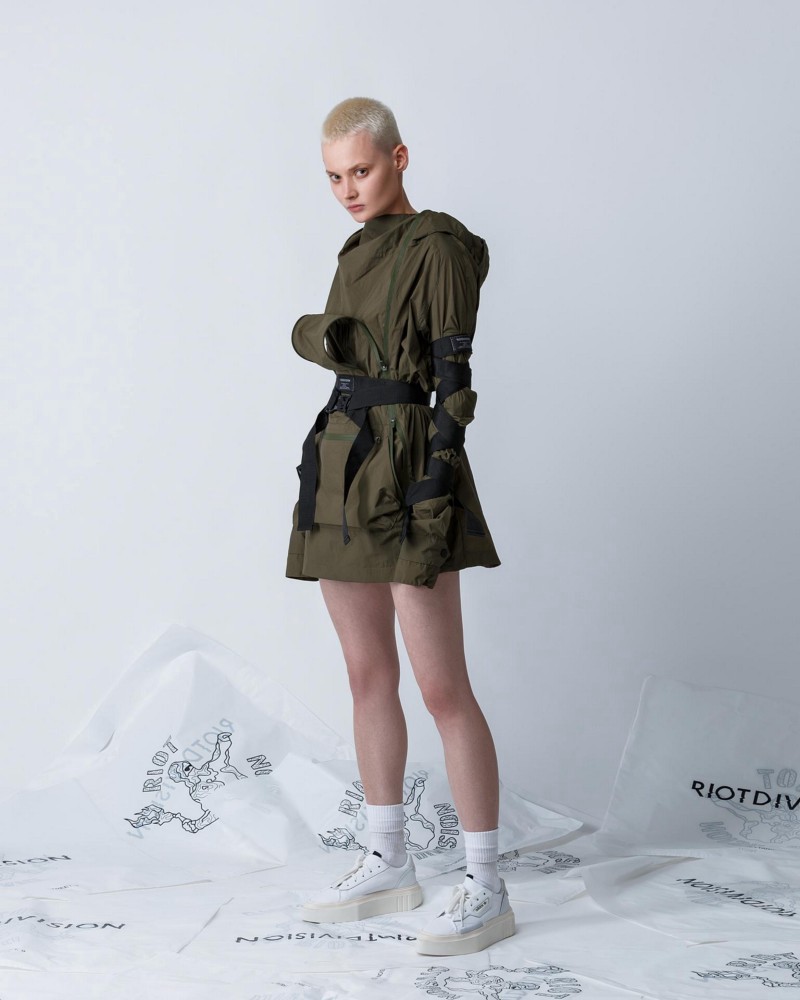
Riot Division’s recent campaign depicting a female-presenting person in a dress is a perfect example of how techwear is designed for (and to appeal to) cisgendered, heterosexual men. I was so excited to see a popular techwear brand make a dress until I learned it was not a dress at all: It is a men’s parka belted to fit like a minidress. Worn this way, it loses the utility techwear promises. It is not a functional garment; it is eye candy.
When clothing is designed for a particular body (male, thin), everyone who does not have that body must compromise, and compromise is where techwear loses value to the wearer. Ill-fitting gear is ineffective gear.
Another contributing factor toward a male-centric techwear aesthetic is the dominant influence of military gear.
There is an entirely separate lineage of women designed performance-oriented fashion without military influence. Consider Norma Kamali who, as reported by Elle, “created the All-in-One tunic you can wear eight ways (1974), foil cutout bathing suits (early 1990s), a Living Rubber collection in which the fabric changed color like a mood ring (1999), and a sleeping-bag coat (1975) — all iconic pieces.”
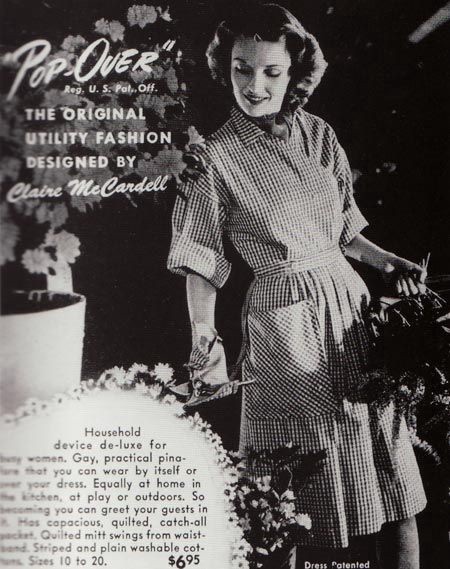
The modern invention of sportswear in the 1920s is defined by its practicality for the American woman to dress herself without help from a maid. Sportswear was created to allow women to, you know, do things. Richard Martin at the Metropolitan Museum of Art notes that we are all…
…indebted to McCardell, Cashin, Hawes, Wilkens, Leser, and Maxwell, and other women who liberated American fashion from the thralldom of Parisian design. Independence came in tying, wrapping, stowing, eschewing ornament, harmonizing, and rationalizing that wardrobe. These designers established the modern dress code, letting playsuits and other activewear outfits suffice for casual clothing; allowing pants to enter the wardrobe, often as an alternative in an outfit also offering a skirt; and prizing rationalism and versatility in dress, in contradiction to dressing for an occasion or allotment of the day. Fashion in America was logical and answerable to the will of the women who wore it.
This is a fundamental lineage of techwear without roots in a male-centered military aesthetic. Skirts can be utilitarian. Dresses can be technically performant.
So where is the femme techwear? Where is a techwear informed by feminine-coded clothing attributes? ADAY and Les Lunes are active in this space. But a major problem is that women’s techwear is often dismissed and devalued as “athleisure.”
When men wear clothing made for movement, composed of technical materials that embodies a futuristic or avant garde mentality, it is labeled Techwear — capital T! Fashion — capital F! When women wear clothing made for movement, composed of technical materials that embodies a futuristic or avant garde mentality, it is called athleisure.
Athleisure is demeaned as lazy, and it produces screeds by columnists fist-shaking at women for having the audacity to wear yoga pants outside the gym. But Lululemon is making some of the most stylish technical clothing for women. Stella McCartney for Adidas, Charli Cohen, Nikelab x JFS, Sacai x Nikelab are all making interesting, avant-garde techwear that is often lumped into “athleisure”.
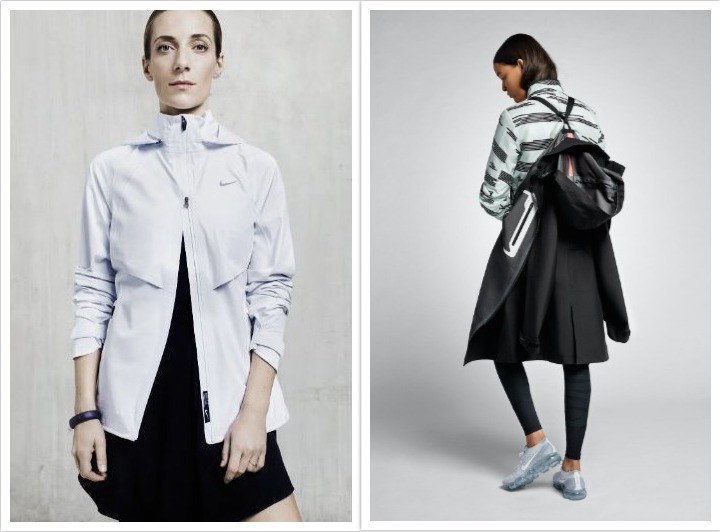
As an aside, while techwear’s reverence for Acronym’s Errolson Hugh veers toward hero worship, I have never seen a single reference on r/techwearclothing to Johanna F. Schneider, who also designs for Acronym, Stone Island Shadow Project, the Nike collaboration referenced above and others. Her work is an important contribution to the aesthetic and should be recognized.
To answer the original redditor’s question, no. r/techwearclothing (and techwear) is not only for men. But it is exceedingly difficult to create interesting, functional fits when the majority of high valued designers are men, producing clothing for a male-centered aesthetic, sized and fit for men’s bodies.
There is nothing inherently masculine about techwear. The hyperfocus on Acronym and other military-inspired apparel, as well as grayman brands like Outlier and Veilance that only design for a cis male body, is exclusionary. It ignores an entire lineage of design that could influence the aesthetic in new and exciting ways. To stay interesting and relevant, to keep innovating, to remain avant-garde, techwear needs to make room for all gender expressions and bodies.
This article is a lightly edited version of Ghost Lux’s Medium article “Techwear’s Gender Problem”.


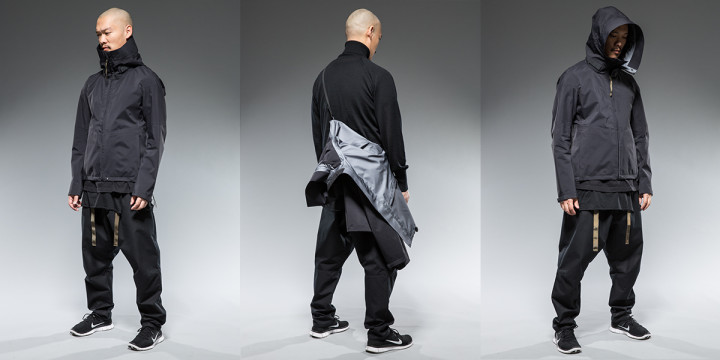

Thank you so much for publishing this! I’m a really tall woman wih an interest in techwear and this article really gave voice to a lot of thoughts I’ve had! Many thanks <3
Thank you! This is such a well written article. It’s part of the reason why I’ve been finding it difficult to get into techwear, since part of functional clothes would be them fitting (sweaterpaws are not really part of my style, I’d just like things to be the proper length and width, doesn’t have to be perfect, but some structure, some items that have darts- for some of the bigger chested bustdarts would probably make it a lot more feasible- ),it is really hard to rationalize spending a lot of money on something that you know won’t fit, or will have to be altered. Just let me have functional stuff, pockets, and advanced fabrics too, please.